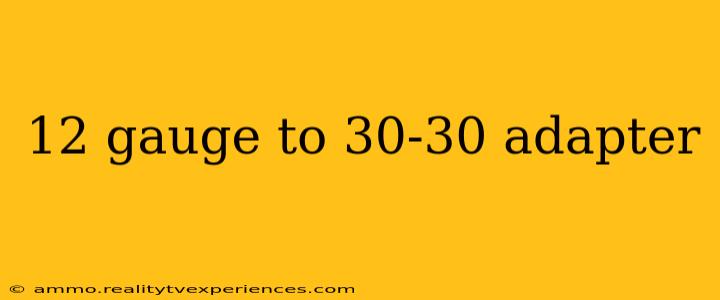The idea of adapting a 12-gauge shotgun to fire .30-30 ammunition might seem appealing, particularly in survival scenarios or niche shooting sports. However, before diving into the mechanics, it's crucial to understand that creating or using a 12-gauge to .30-30 adapter is extremely dangerous and highly discouraged. There's no commercially available, safe adapter for this conversion, and attempting to build one yourself could result in serious injury or death.
Why a Direct Conversion is Impractical and Perilous
The fundamental incompatibility between a 12-gauge shotgun and .30-30 ammunition lies in their drastically different designs:
-
Shell Size and Shape: 12-gauge shells are significantly larger and wider than .30-30 cartridges. The 12-gauge's cylindrical bore is designed for the dispersion of shot or a slug, while the .30-30 cartridge is a bottlenecked, rimmed round designed for rifled barrels. Forcing a .30-30 round into a 12-gauge barrel would be extremely difficult and likely to cause a catastrophic malfunction.
-
Chamber Pressure: .30-30 ammunition generates significantly higher pressures than a 12-gauge shotgun firing a standard load. A 12-gauge shotgun is not designed to withstand these pressures. Attempting to fire a .30-30 round in a modified 12-gauge barrel would almost certainly result in a barrel rupture, potentially causing severe injury or death to the shooter and those nearby.
-
Rifling: .30-30 ammunition relies on rifling within the barrel to stabilize the bullet's flight. A smooth-bore 12-gauge barrel lacks this rifling, leading to wildly inaccurate and potentially dangerous projectile trajectory. The bullet could veer off course unpredictably, increasing the risk of unintended harm.
Exploring Safer Alternatives
Instead of pursuing the dangerous path of creating a 12-gauge to .30-30 adapter, consider these safer and more practical alternatives:
-
Carrying both a shotgun and a rifle: This is the most straightforward and safest solution. Carrying a separate firearm chambered in .30-30 eliminates the need for risky modifications and ensures the reliable performance of both weapons.
-
Choosing a versatile caliber: Select a firearm chambered in a caliber that addresses your needs in diverse situations. Some rifles offer versatility in the types of ammunition they can effectively utilize.
-
Understanding ammunition types: Research and choose the appropriate ammunition for your intended purpose. Understanding the ballistics of different cartridges can help you make informed decisions about the best tool for the job.
The Importance of Safety First
Improvising firearm modifications is exceptionally dangerous and should be avoided at all costs. The potential for severe injury or fatality significantly outweighs any perceived benefit. Always prioritize firearm safety and adhere to all relevant safety guidelines and regulations. Consult with experienced firearms professionals for guidance on safe firearm handling and ammunition selection. Improvisation in this arena is a recipe for disaster.
Disclaimer: This information is provided for educational purposes only. The author and publisher are not responsible for any injuries or damages resulting from attempting to modify firearms or use them in an unsafe manner. Always prioritize safety and consult with qualified professionals before undertaking any firearm-related projects or modifications.

